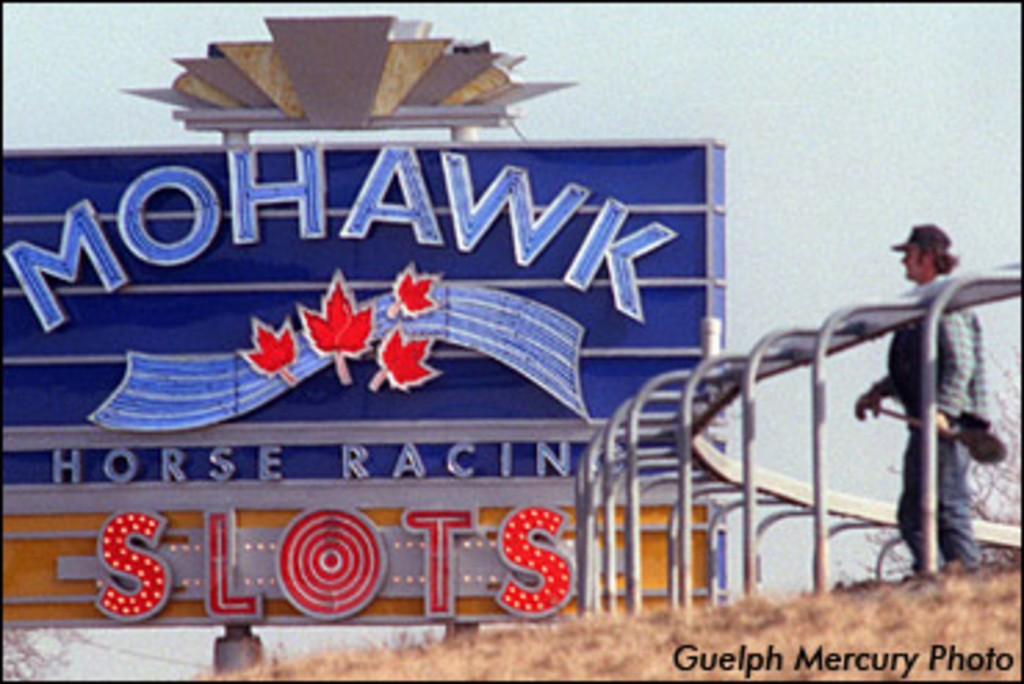
It hasn't quite reached the cross just yet, but if Dwight Duncan, provincial minister of finance, and Paul Godfrey, chair of the Ontario Lottery and Gaming Corporation, continue their destructive attack on horsemen's revenue earned at its 17 Ontario horse racing facilities, the death knell to a vital industry could be near
.
The issue remains a $345 million question. Is it a “subsidy” or is it a “rebate” from a contractual agreement of slot revenues at racetracks?
It all began with Sir Donald Drummond's report on behalf of the McGuinty Liberals on how to cut expenses and raise funds to wrestle down the $16 billion deficit at Queen's Park. Drummond's 668-page report listed 362 cost saving recommendations that could return millions to melt down a growing deficit. So where does this contentious $345 million come into play?
Before we delve into this Liberal take-away, may we go back a half century for a perspective on the impact of horse racing in the province of Ontario.
Always self-sustaining, the introduction of night harness racing in 1961 evolved as “the only game in town” offering legalized wagering and opening up an avenue for a fledgling sport and economic force in this province.
With the success of horse racing after dark came millions from taxes on wagering dollars funneled into the coffers of Canadian governments. The provincial folks return a small portion of these taxes to the racing industry as a “rebate.” These dollars originated at the tracks.
At this time, when horse racing was called the fastest growing sport on the continent, a host of outside influences were about to emerge and challenge the racing game for the entertainment dollar.
It was in 1975 when the provincial bureaucrats decided they needed to augment their slumping budgets and introduced the Ontario lotteries. The lottery and regulated bingos today have grown to generate $3.3 billion in annual revenue and undoubtedly have siphoned millions from wagering at racetracks.
Again, horse racing was compelled to counter the decline of racetrack patrons by implementing simulcast betting at all its tracks.
Suffering from live activity at their facilities, the inter-track model of simulcast offers instant wagering from a multitude of racetracks around the world. Simulcast betting at some tracks represents somewhere around two-thirds of the total bets. Technology today offers wagering opportunities at home on phones, online and yes, iPads and cells.
Now, the crux was about to become a reality. A whole new challenge was on the horizon for a threatened Ontario horse racing industry.
It was in the late 1980s when the then NDP Queen's Park powers began a crusade for casinos in the once pure land of the Trillium. Their mandate was to intercept some of the millions leaving here for Las Vegas, citing the support for Ontario's economy rather than Nevada's.
Bob Rae's visionaries were to establish gambling halls in all the metropolitan areas of the province, pending the approval of the Criminal Code. Horse racing said, “No way. You are going to adversely affect the many hands that feed you.”
Following the change of the guard at the provincial capital and after many consultations with the horse breeding and racing bureaucracy, Michael Harris' Conservatives agreed that a partnership to establish slot casinos at the racetracks would be a stimulus to all the economies concerned. A deal was struck with the racetracks providing the slot facilities. In return, the horse industry would receive 20% of the gross revenue from the track slots. The government walked away with 75% and the racetrack municipal communities received 5% of the slot revenue.
Windsor Raceway inaugurated slot parlours in 1998 and now will be closed as well as Sarnia and Fort Erie.
During its 14-year partnership, Queen's Park received over $1 billion annually with the horse racing and breeding industry generating a $2 billion annual economic impact in Ontario. Eighty percent of nearly $2 billion of expenditures are spent in rural municipalities - the second largest subsection of Ontario's agriculture economy. And how about these 32,000 full-time horse-related jobs and another 30,000 indirect employees.
The consequences for the meaning of the words for the $345 million subsidy grants or rebates doesn't really matter. What does the abandoning of a $345 million contractual agreement without a proper dialogue matter?
May it be said, forgive you politicians for you know not what you are doing.
Roll away the stone, open the tomb and get back to the table, a resurrection is in order.
(Written by Don McNiven, as published in the Ingersoll Times (Ingersoll, Ontario) on Wednesday, April 4, 2012)


Well written very true, for
Well written very true, for another look at the devastation the end of the slots at reactracks will have on our industry please read the excellent article in the Sudbury star about Murray McConnel and Casimir farm.
Well said. How appropriate
Well said. How appropriate for Good Friday. This article is factual and to the point. Surely the Liberals will wake up and see what a travesty they are setting upon the province of Ontario. We're all just sick about it ... it's unimaginable that a political party should be able to make decisions without researching the consequences. I know it has all been said already. Just wish there was a way to achieve some kind of compromise. Chris
Thank you Don (and Jack!!).
Thank you Don (and Jack!!). Well said . will print it off and keep it for others to read!
Dave Aziz
Excellent Don, well written,
Excellent Don, well written, historically accurate and to the point. Will our industry ever get the courtesy of a peek at the grand plan or have we been selected for elimination arbitrarily? The unnerving part is that there may be no plan.
Regards,
Brian Webster
Thank you Don for a well
Thank you Don for a well written documented history of the horse racing industry and slots program. Let's hope that the politicians take note and come to their senses.